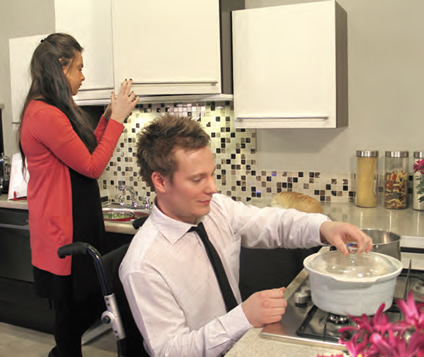 Cooking is one of life’s greatest and most simple pleasures. If you enjoy it, you are engaging in an activity that is creative and healthy. When you have a permanent or temporary disability, cooking can become challenging. Few standard kitchens have the right access levels, and may even have the wrong depth. No two disabilities are the same, but there are some general ways to make sure you continue cooking as a disabled person, while still being able to enjoy the process.
Cooking is one of life’s greatest and most simple pleasures. If you enjoy it, you are engaging in an activity that is creative and healthy. When you have a permanent or temporary disability, cooking can become challenging. Few standard kitchens have the right access levels, and may even have the wrong depth. No two disabilities are the same, but there are some general ways to make sure you continue cooking as a disabled person, while still being able to enjoy the process.
Finding the Right Tools
Adaptive equipment certainly isn’t the norm, but it is out there. The number of adaptive products for disabled individuals is starting to grow. Alongside an accessible kitchen, they streamline the cooking process. For example, you can find chopping boards that also have areas for storing knives. This means you spend less time moving around, and more time focusing on cooking.
You can also use everyday tools to make cooking easier. Many vegetable baskets are now quite low; why not expand their use and include other food items in them? You may also want to consider using a push cart, which makes carrying food from area to area easier.
Enjoying cooking when you have a disability isn’t just about accessibility, you also need to find ways to make it safer. Ensuring you have grips on your chopping boards as you adapt to disabled cooking is essential. You may also want to carry hand hygiene wash and use disposable gloves if you use a wheelchair. This minimises the spread of pathogens from your kitchen to your wheelchair.
Adapting Your Kitchen
Depending on the nature of your disability, you may want to consider adapting your kitchen. Lowering your kitchen sides and reducing their depth makes it easier to cook dishes when you are in a wheelchair. You may also want to consider whether your current kitchen surfaces are easy to clean. When you have a physical disability, having smooth surfaces with minimal equipment clogging them makes it easier to clean following spillages and the preparation of meats.
When purchasing larger appliances, pay attention to how well they grip onto your surfaces. Certain appliances can even make life easier, even when manufacturers do not produce them with disabilities in mind. Take bread makers, for example; you can use them to make cakes, jams, and dough, which removes a lot of the hassle you usually associate with prepping for such foods. Appliances become more innovative each day, so keep your eye out for anything that reduces the number of pans you need to use and items that can do tasks for you.
Approaching Cooking with Care
Prepping is a key part of any budding chef’s arsenal, whether you have a disability or not. When you know what you want to cook, get everything out and prepare it in advance. This minimises organisational chaos and makes cooking faster. It also means you spend less time going to the fridge or store cupboard.
Having a clear space to cook in before you begin is also essential. While innovative appliances often come in handy, they also lead to accidents and reduce the amount of room you have to cook. This is especially dangerous when you are chopping veg and meat, as mixing the two can lead to cross contamination and food poisoning.
Even if you enjoy cooking, there is no harm cooking in bulk to save time and prevent fatigue. This is extra useful if you suffer from a condition that causes fatigue, as it allows you to relax during those days when cooking requires too much effort. Make the most of your freezer and cook in bulk when your energy is there.
Cooking can remain as an enjoyable pastime when you have a disability. With the right approach and a few adaptations, you can produce enviably tasty dishes at your convenience.